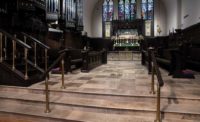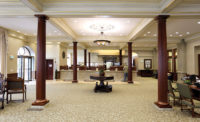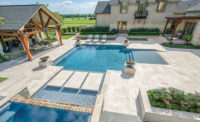A recent renovation to Founders Hall — located on the campus of Naugatuck Valley Community College (NVCC) in Waterbury, CT — was a collaborative effort between school administration, the design team at Moser Pilon Nelson, Architects, LLC, Stony Creek Quarry Corporation and additional stone industry professionals who were involved in the fabrication and installation of the stone used for the project. From the onset, it was important to the school that regional stone was chosen and that the material also withstand heavy foot traffic and harsh winter weather. In the end, the decision was made to use Stony Creek granite — a stone showcased on many high-profile landmarks such as the pedestal of the Statue of Liberty and The Smithsonian in Washington, DC, and quarried nearby in Branford, CT.
“Just before I became president of NVCC in 2008, a study was conducted to determine the needs of the college and the program,” explained Daisy Cocco De Filippis, Ph.D., president of NVCC. “Founders Hall is the original home of the Waterbury State Technical College, merged with Mattatuck Community College in 1992, to form Naugatuck Valley Community College. The renovation honors a place that holds many fond memories for our alumni, faculty and staff. It supports, with state-of-the-art facilities, our excellent allied health and nursing programs responsible for the careers of so many talented professionals in health science who now support our communities through their contributions to the workforce and the care provided to so many in hospitals in our service area, of particular importance, Waterbury Hospital and St. Mary’s Hospital, as well as so many others.”
The design
In talking with the architects prior to starting the design process, the school administration expressed several design objectives. “We communicated the importance of community colleges to the creation of the middle class in Connecticut,” said Cocco De Filippis. “We wanted to show respect for the communities we educate and serve, and a sense of faith, trust and hope in a solid future for the communities by means of a strong community college presence and contribution. We also wanted to communicate calmness, gentleness and care.”
When it came to the building material, those involved in the project wanted it to be “naturally beautiful and not man-made,” according to Cocco De Filippis. “We wanted it to be from Connecticut, and we wanted to communicate serenity, stability, beauty and respect.”
But of course, budget comes into play and when contractor bids came in high, the State suggested areas to cut expense, including swapping granite for a terrazzo floor, explained James Troupe, provost and senior dean of administration of NVCC. “The president and I made it known to the State that wasn’t a cut we wanted,” he said. “We wanted to maintain that Stony Creek granite floor.
“We won the battle,” Troup went on to say. “It was agreed the Stony Creek granite floor would stay as proposed. We knew it would be the hallmark of the building. We also received LEED points for it since the Stony Creek Quarry was close by.”
Troup explained he really liked that the granite was from the region. “I become more attached to the idea and what it would look like,” he said. “I went to the quarry and timed it so I could see the blocks cut from the mountain.”
Architect Richard B. Brown, AIA, principal at Moser Pilon Nelson, Architects, LLC in Wethersfield, CT, explained Stony Creek was also chosen for its inherent traits and sustainable qualities. The granite was used for the exterior base course of the building, with a thermal finish and thickness of 3 5/8 inches to match the brick that was also used, as well as for the interior floor and staircase.
“The senior administration of the college reviewed all of the flooring material [options] for the lobby,” said Brown. “It was ultimately their decision. They looked at the short- and long-term cost, as well as its beauty. They also liked it was an historic granite used on the Statue of Liberty and that it was local to New Haven county. It’s an attractive product. We specifically like the grain in the rock; you can see the pattern. It’s not typical of all materials.”
Brown went on to explain he typically specifies granite on the outside of a building down near grade level. “It takes abuse,” he said. “It isn’t [harmed] by a weed whacker and it doesn’t dissolve when salt is thrown down in the winter.”
In addition to the exterior base of the building, Stony Creek granite was used for large 16-inch x 4-foot bollards at the entrance of Founders Hall, as well as for a sculptural base. The material also provides the endurance needed for the lobby floor and staircase. Complementing the local granite is Virginia Mist granite, which was also employed for the floor. The floor pieces were all custom cut — each measuring 2 x 2 x 1 ½ inches thick.
“We always use stone to the extent we can afford to use it,” explained Brown. “One of the comments I heard from people [about Stony Creek granite] was I didn’t think I could get something this nice from Connecticut. The lobby floor was installed last winter and looks like it was installed yesterday. It lives up to its billing.”
Working with the quarry
According to Darrell Petit of Stony Creek Quarry Corporation, this project was a landmark job for the company in several ways. “This is a community college in the state of Connecticut,” he said. “For the last 10 years, we have focused on getting into the State’s spec. This was a success in that regard.
“The client is the State, and Jim and architect Rich Brown really focused on wanting Stony Creek granite because it is local to Connecticut with unique geological characteristics and it’s historical,” continued Petit, adding Stony Creek Granite Corp. had recently received the ANSI/NSC 373 Sustainable Dimension Stone Gold Certification, a voluntary accreditation that involves an intensive document submittal, which is verified by an onsite audit conducted by NSF International. “In choosing our granite, they made a consequential choice. This was a sustainable stone decision that we are seeing more and more of. It was the right thing to do for the college, for Connecticut, for the legacy of Stony Creek Granite and for the environment.
Petit explained that the architect devoted a great amount of effort to ensuring the Stony Creek granite would be specified for the job. “Rich [Brown] was the catalyst,” he said. “He was extremely loyal in making visits to the quarry with Jim. From then on, he went into intensive back and forth dialogue to engage us to write an extraordinary specification. It was true to the stone’s characteristics and located us geologically. It was far beyond the general boiler plate specification we see all the time. It was very focused on the facts that authenticated the geological origins of the material.”
Petit believes there are challenges when it comes to having a particular material specified for a project only to see the client and architect lose their choice of material because of ambiguous language of a weakly written spec and the subsequent intervention of unauthentic substitute materials — the loss of control of the spec is often at the client’s and architect’s expense. “But if an architects knows what they want, they can reach out to the quarry first to consult with them to write a high quality spec and they can usually get what they want as Moser Pilon Nelson clearly showed here on this project,” he said.
“[Once our granite was specified], we already had the relationship so they could trust us,” Petit went on to say. “Although we were not holding the supply agreements — those went to fabricators who are our partners — they kept us in the loop to help clear up any issues they might have occurred within the process. A quarry knows its material best.”
The floor tiles of the main lobby had a honed finish. “They wanted a certain level of hone that would hold the light,” explained Petit. “We lined them up with our partners A. Lacroix Granit who we believe in and who has the experience and hands on expertise with the variegated nature of our material. [Also], we worked quite closely with Joseph Cohn & Son, Inc., the installer for the interior lobby floor. They did a wonderful job. It was a great example of collaboration.”
Petit explained the exterior bollards required some hand tooling work. “We know Granites of America and their craftsmen quite well,” he said. “We could only suggest because they were State bids, but we knew who could achieve the details the best.”
In the end, the teamwork between all parties involved resulted in a successful outcome, as the school administration is very pleased with the finished work.













